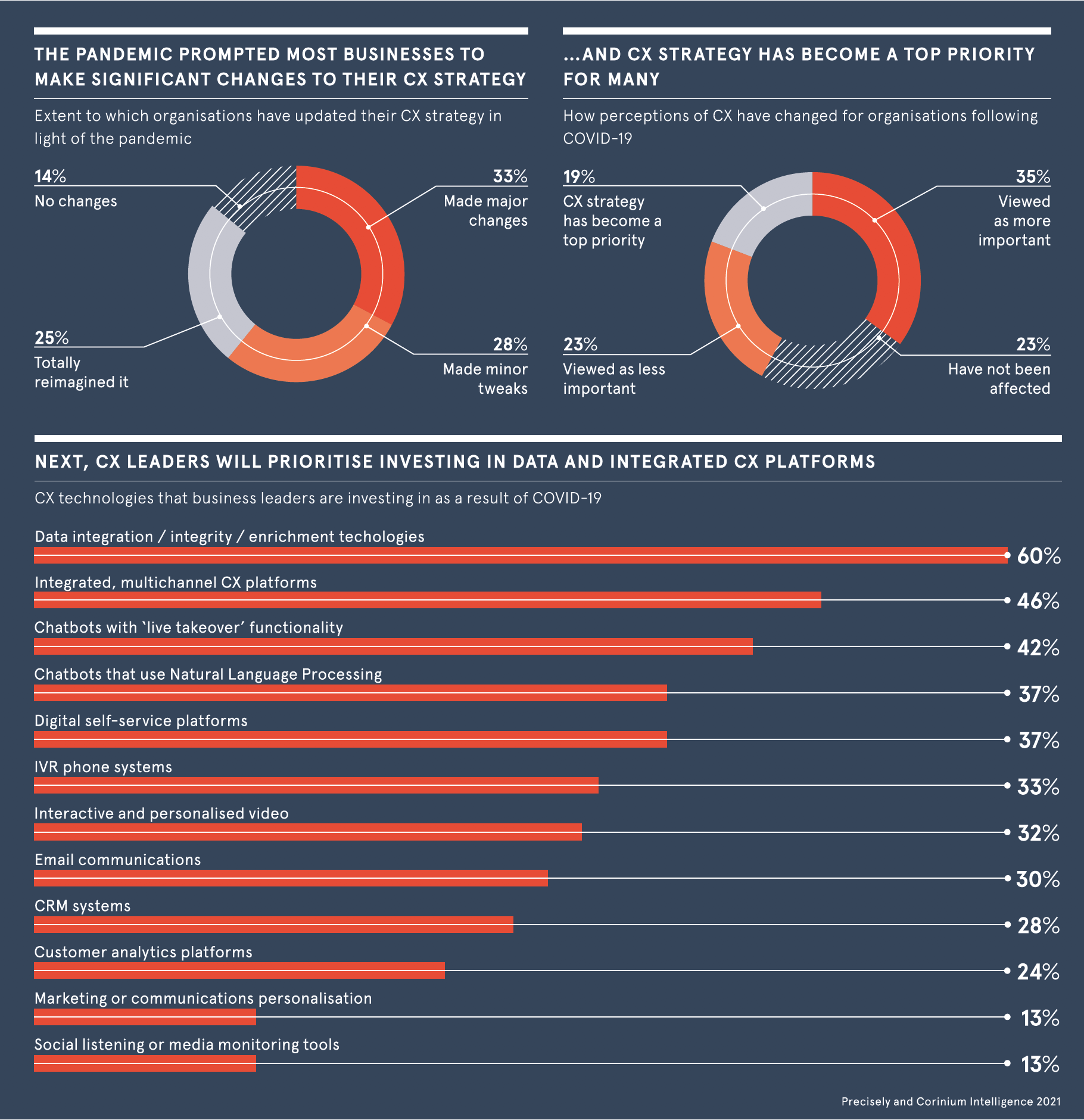
There remains much that is uncertain about the coronavirus pandemic but there are two facts about which we can be sure: one, there has been a massive acceleration of digital transformation efforts; and two, post-pandemic customer behaviours will be more omnichannel and need more online and offline integration than ever before. Customers are going to make even bigger demands of brands and organisations are worried they won’t match up.
Research from Precisely illustrates the challenge. Increasingly, customers are replacing in-person interactions with online alternatives. More than three-quarters (79%) of executives surveyed stated that the volume of their website interactions had increased, while 59% saw more activity in apps and 57% on messaging platforms or via chatbot.
However, 67% agreed that customers generally still want to speak directly to a human and 64% believed their customers were overwhelmed by the volume of communications they receive. There is clearly a need to make sure companies are interacting with customers wherever they are, with messaging that is appropriate and in a format that’s easy to consume. It sounds simple but, as many organisations recognise, it can prove very complex to solve.
Build an agile, intuitive technology base
“Tying together the customer journey makes big demands of many businesses that are often operating on decades-old legacy technology,” says Greg van den Heuvel, executive vice-president and general manager of EngageOne Solutions at Precisely. “Even companies that have already begun a digital transformation journey encounter problems. By moving towards API-based technologies, organisations can make true omnichannel customer experiences a reality.”
There is a perception that new technologies are difficult to onboard, adapt and train staff on. Newer, API-based solutions have none of the inflexibility, fewer redundancies and greater ease of integration, making them the obvious solution to the question of omnichannel transformation.
EngageOne Communicate is one such system that brings together standard customer communication channels – email and SMS – with more advanced methods such as chatbots and interactive video. It is also an example of what is called a low code technology.
While it has the potential to be customised and adapted by a skilled internal IT team to meet very specific, advanced needs, it can also be used ‘out of the box’ by most employees. It is part of the generation of enterprise tools that have taken their cue from the consumer space, using recognisable features such as ‘drag and drop’. Employees don’t have to be power users of the system to get up and running with polished-looking communications, which also means they can get campaigns off the ground from ideation to completion in days, rather than weeks or months.
Integrate data for the complete picture
Of course, a slick campaign created on a slick interface is worth very little unless the message is meaningful to customers. Personalisation is also a key part of the omnichannel experience. Executives surveyed in the Precisely research concurred, with 60% stating their number one priority for 2021 was to invest in data integration, integrity or enrichment technologies.
There is a clear and immediate need for platforms that instantly connect to data in real time to allow personalised interactions across all channels. They also need to provide data access and analytics that allow companies to identify gaps in the customer journey.

The key to successful personalisation isn’t just having that wealth of data at your fingertips, it’s being able to use it.
Training a wide swathe of employees in data analysis and onboarding is one option but it is time-consuming and successful organisations thrive when there is a balance of skills, not a large cohort of single-skilled members. Choosing platforms that make it easy to access data and understand the insights data provides, as well as the best next steps, is the most effective way of making the most of the workforce.
“The easier a system is to use, the more likely people are to use it,” explains van den Heuvel. “This empowers the organisation to create effective campaigns across multiple channels without compromising on the level or precision of personalisation.”
More agility, more collaboration, more satisfaction
Unified platforms like EngageOne Communicate don’t just deliver on speed and simplicity. Teams need to be able to collaborate, iterate and grow. For that, they need solutions that can evolve along with them.
“For companies used to email and SMS, the leap to video and chatbot can seem daunting, but this is increasingly how customers choose to interact with businesses,” continues van den Heuvel. “If the employee user experience is simplified, providing these next level experiences shouldn’t prove challenging at all.”
Blue Shield of California, a health insurance provider, initially launched a personalised interactive video service where customers could compare health insurance policies – a difficult task to complete without expert guidance. Video was not a ‘nice to have’, it was an elegant yet simple solution to a complex need.
Each Blue Shield video concludes with a survey, and 83% of prospective members have rated their video four or five stars (out of five). Most important, after interacting with their videos, 73% of viewers have indicated that they are likely to choose a Blue Shield plan.
Having seen how easily it could create interactive videos, even ones tailored to individual users’ needs, the company then went on to add an integrated chatbot function.
This allows prospective members to find a doctor or ask detailed questions about their plan choices. There is still the option of allowing humans to step in, but this digitised, cross-channel, personalised journey shows how unified platforms can increase customer satisfaction and business efficiency.
Continuing to deliver on customer experience means maintaining an agile approach and open mindset to emerging trends and the future needs of the business. For some companies, the goal is affordable scalability. This means acquiring a solution that doesn’t just address a business’s needs as its grows, but is also cost and feature-appropriate to its needs today.
The way forward from a vendor perspective is to design products that don’t just help companies collaborate internally but can help them work at different speeds, acknowledging the varying levels of need in the organisation. Today’s needs may be to support day-to-day marketing; tomorrow, more custom approaches designed in-house by IT specialists may be required.
“Future digital transformation is a given,” van den Heuvel concludes, “but it should be evolutionary, not disruptive or painful. A platform like EngageOne Communicate is designed to allow companies to scale at their own pace – and that of their customers – whether they’re an SME or FTSE 100 company. From low code to high tech, cost savings to deeper creativity, there is something for everyone.”
To find out more, visit www.precisely.com/product/engageone-communicate
Promoted by Precisely

There remains much that is uncertain about the coronavirus pandemic but there are two facts about which we can be sure: one, there has been a massive acceleration of digital transformation efforts; and two, post-pandemic customer behaviours will be more omnichannel and need more online and offline integration than ever before. Customers are going to make even bigger demands of brands and organisations are worried they won’t match up.
Research from Precisely illustrates the challenge. Increasingly, customers are replacing in-person interactions with online alternatives. More than three-quarters (79%) of executives surveyed stated that the volume of their website interactions had increased, while 59% saw more activity in apps and 57% on messaging platforms or via chatbot.
However, 67% agreed that customers generally still want to speak directly to a human and 64% believed their customers were overwhelmed by the volume of communications they receive. There is clearly a need to make sure companies are interacting with customers wherever they are, with messaging that is appropriate and in a format that’s easy to consume. It sounds simple but, as many organisations recognise, it can prove very complex to solve.

